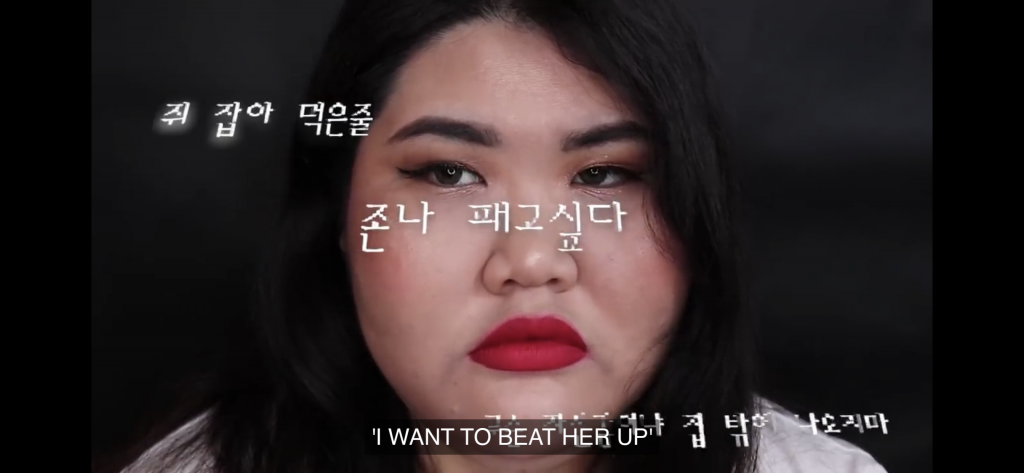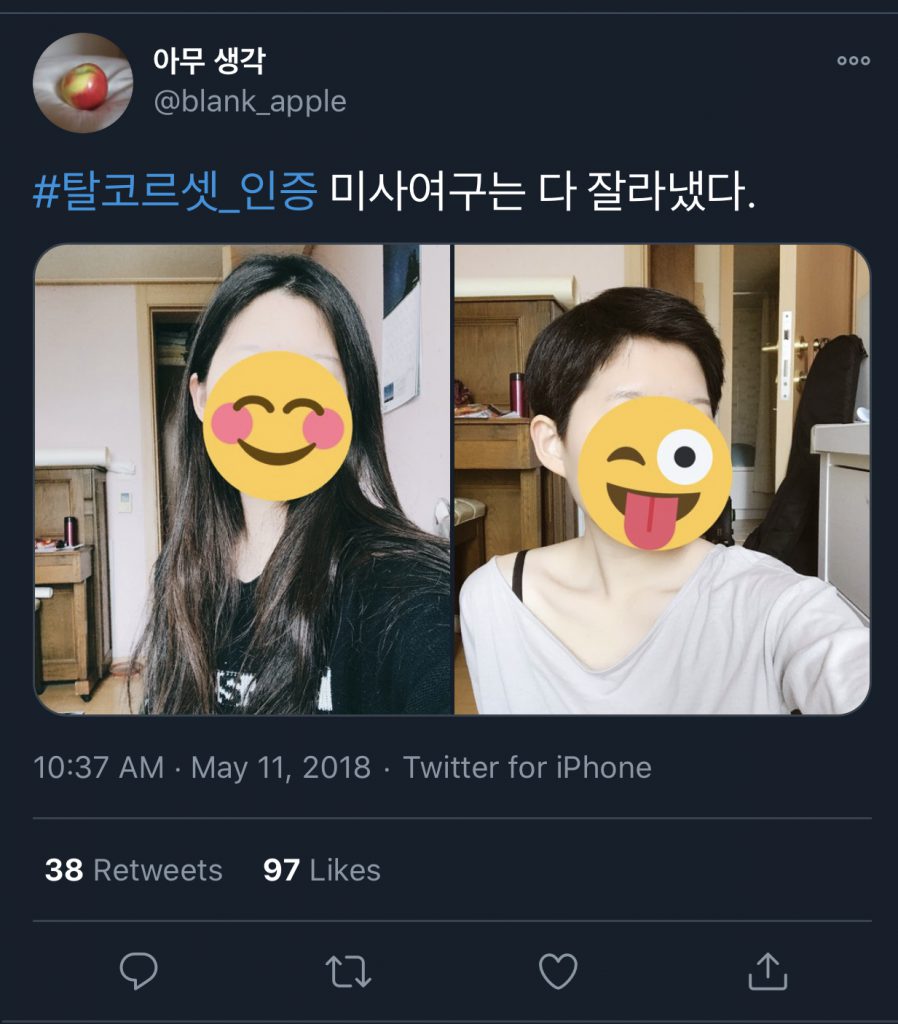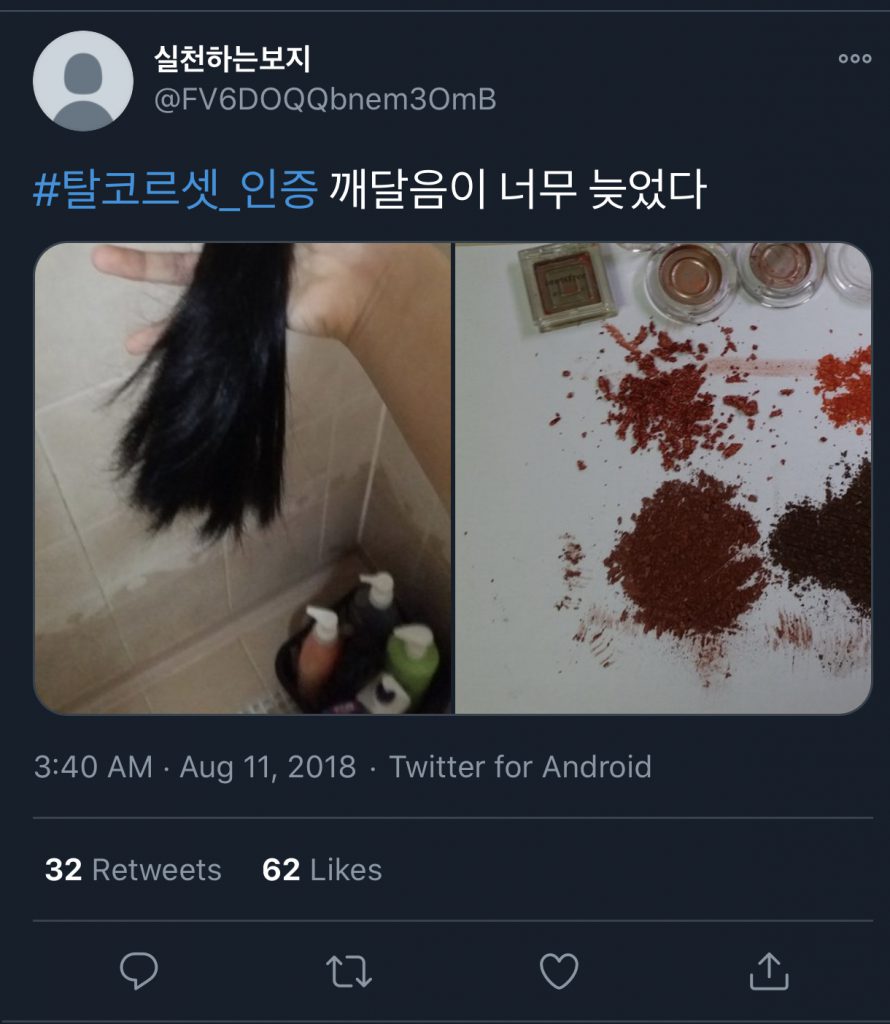Just as K-pop has become a worldwide sensation through video virality (think of rapper PSY’s (Park Jae-Sang’s) 2012 viral hit “Gangnam Style”), South Korea’s #EscapeTheCorset movement has become globally visible through the connectivity of social media.18 In June 2018, YouTuber and makeup vlogger Lina Bae became the international face of the movement when she posted a video called, “I am not pretty. (나는예쁘지않습니다.),” which has to date received almost 1 billion views.19 In it, she painstakingly puts on a full face of makeup and then immediately removes it, while comments that she has received during her makeup tutorials such as “Even pigs wear makeup” and “Why is your skin so dirty?” scroll down at various angles of the screen.20 She ends the video with words of encouragement: “It’s ok if you’re not beautiful or skinny. You can find your own way. Don’t make yourself up for others.”21 The slogan “Escape the corset” does not originate in South Korea but rather can be traced back to the 1968 Miss America pageant when young American women protested the event by throwing their skirts, false eyelashes, high heels, and girdles into a trash can, which they dubbed “the freedom can.”22 From there, escaping the corset both literally as a constrictive piece of clothing and figuratively as a metaphor for feminine beauty ideals, became a central tenet of second wave feminism in the US. Similarly, young feminists today utilize the slogan to encapsulate the restrictive nature of the beauty regimens imposed upon and expected of feminine bodies. As Bae explains in the caption under her “I am not pretty.” video: “In detail, women are forced to wear a corset that makes one wake up an hour or two earlier to get ready.”23
If Womenlink’s main focus was lookism as a form of gender inequality within South Korea, then digital feminists focus on the labor such lookism demands of them. Bae illuminates that for young Korean women today, the corset they are forced to wear is “base, eyebrow, and lip makeup.”24 Yet, these cannot simply be put on, they must be applied in a process that takes hours of grooming before leaving the house. By emphasizing this, Bae and other digital feminists are quantifying the labor these beauty regimens require, known in Korean as “embellishment labor” (꾸민노동). And by recounting what coworkers would commonly say if one does not wear makeup to work (“You really don’t care about how you look,” “You look sick”), Bae points out the ways in which beauty expectations have normalized to the point of daily toxicity (the same daily toxicity that scrolls throughout her video).25
Although Bae’s video received a lot of international attention, other South Korean women were also actively rejecting beauty standards via social media. For example, on May 11, 2018, @blank_apple tweeted a before photo with long hair alongside an after photo featuring a pixie cut. The photos were accompanied with the caption: “The pretty packaging has been cut (미사여구는 다 잘아냈다).”26 @FV6DOQQbnem3OmB’s August 11 tweet features her sheared locks and smashed cosmetics with the statement, “Enlightenment has come too late (깨달음이 너무 늦었다),”27 illustrating that by late summer of that year, the movement was in full swing. These posts, however, are a means to an end, not an end in and of themselves. That is to say, the hashtag does not merely announce active refusal and withdrawal from beauty’s labor, but also signals the emergence of something else altogether: the possibilities opened up with that newfound time, energy, and money. For example, after cutting her hair short and giving up her makeup routine, feminist Cha Ji-won not only saves $700 a month, but uses the same mental and physical energy she spent on her looks towards her YouTube channel dedicated to feminism called “한국여자 Korean Womyn.”28 Bae has used her platform to write a book with the same title as her now famous video “I’m not pretty.” In these ways, young feminists point out that makeup is a critical part of women’s economic participation and a form of uncompensated labor, the value of which can be recuperated through other, more meaningful endeavors.
What makes #EscapeTheCorset particularly salient, however, is that in illuminating the local South Korean context, it is also connects these gendered labor demands to other movements to address gendered violence across the globe. For instance, at the end of 2018 @DrAishaKGill tweeted, “This is brilliant. Female fightback in 2018 in hastags (sic).”29 @DrAishaKGill followed this with the following hashtags: “#MosqueMeToo #thetotalshutdown #saudiwomencandrive #escapethecorset #Cuentalo #dancingisnotacrime #ThisisNotConsent #equalpay.” Evoking the most influential feminist microrebellions of 2018, including Saudi women’s winning the right to drive (#saudiwomencandrive ) and gender pay inequality in England (#equalpay), for example, these hashtags side-by-side put into conversation women’s resistance in Iran, Saudi Arabia, Spain, South Africa, Russia, Ireland, and South Korea, reflecting the sharp rise of transnational feminist protest movements in recent years.30
While Womenlink’s campaigns were extensive, they necessitated, in part, a proselytizing approach that stopped women on the streets to reeducate them on proper ways of “loving their bodies.” Womenlink is a state-funded feminist non-profit organization that received three-quarters of its funding for “Love Your Body” from the South Korean government, the same government that promotes the K-pop, K-beauty, and medical tourism industries (of which cosmetic surgery is the largest market). The government’s sponsorship of Womenlink is illustrative of the ways non-governmental organizations have been used since the Kim Dae Jung administration as “‘surrogate’ social engineers for neoliberal policies.”31 As Jesook Song explains, Kim’s neoliberal regime hijacked the liberal practice of civil/individual freedom of the ten years preceding the IMF Crisis. It is within this backdrop that Womenlink asserted its “Love Your Body” campaign and in this formulation, loving your body or cultivating your inner beauty is the individual agency necessary to counter the seductive practices of the beauty industry. Similarly, “I am the Owner of My Body,” Womenlink’s other anti-beauty slogan, relies on neoliberal logics of self-possession that are not unlike the neoliberal governmentalities that push Korean women to the marketplace for forms of self-management and entrepreneurship in the first place. Relying on the individual rights discourses that characterized the end of the military regime to the IMF Crisis ten years later, Womenlink’s activism highlighted inner selves as paths to liberation waiting to be unlocked within us, yet such self-making is a way of becoming a self-governing subject, able to govern where the state cannot.
In contrast, as Hester Baer has written, “rather than participating in narratives of social progress or emancipation,” digital feminists “emphasize the process of searching for new political paradigms, languages, and symbols that combat the neoliberal reduction of the political to the personal.”32 In this vein, #EscapeTheCorset gains momentum through the collective recognition others experience when they read individual stories of pain or empowerment. For example, Sookmyoung Women’s University’s Feminist Association wrote a declaration of support for the movement in lipstick and eyeliner that read: “Makeup is not my power. Getting dolled up is not my power. Not needing to get dolled up is my power.”33 Afterwards, the association reported that more and more university students were ditching their dresses and skirts in favor of pants and their makeup in favor of short cuts.34 As such, we see the potential for hashtag activism to produce spaces where the answer to feminist dilemmas is no longer specific formations of self-fashioning such as loving oneself, but collective solidarities that produce the possibility of addressing structural inequalities. Digital feminism is “contentiously redoing feminism,” in ways that “deploy the precarious female body to make visible the contradictions of contemporary social reality.”35
Significantly, what makes digital feminism so powerful is that it has occurred in tandem with the rise of street-based protest actions in many parts of the world.36 In South Korea, young feminists have constructed a politics that coheres other digital and on-the-ground movements that foreground violence against women in a multiplicity of connected spheres. Just a month before #EscapeTheCorset made international headlines, tens of thousands of women took to the streets under the slogan “My Life is Not Your Porn” to protest the preponderance of illegal filming of women. The protests were catalyzed when South Korea’s National Police Agency reported that 30,000 incidents of illegal filming have been reported since 2013.37 These incidents are composed of “up skirt” or covert videos in bathrooms, dressing rooms, and even in private residences. In order to help combat these, the city of Seoul hired 8,000 workers in 2018 to inspect the city’s over 20,000 public restrooms daily.38 The backdrop to the spycam protests has been South Korea’s #MeToo movement, which began in 2016 when prominent theater directors were called out for sexual harassment, and garnered more headlines the following year when internationally famous director Kim Ki Duk was fined for slapping an actress and then forcing her to take part in a sex scene on the set of his recent film.39
While seemingly disparate, South Korean young women are connecting these gendered acts of sexual violence with other gendered acts of physical violence. Many young women were shaken by the killing of a woman near Seoul’s Gangnam Station in 2016. The 23-year-old victim was stabbed to death by a male restaurant worker who reportedly said, “I did it because women have always ignored me.”40 Notably, Bae stated that her interest in feminism started after learning about the murder: “The thought that (it) is something that can happen to any woman sent a shiver down my spine.”41 This began her own investigations into the violence she herself was complicit in by being a makeup vlogger. As Bae tells it, comments on her videos from girls who could not go to school without makeup made her think twice about the message of her tutorials.42
While these young feminists do not yet have all the answers, their calls to action and their savvy use of digital platforms signal how young feminists in Korea and elsewhere are creating new collectivities that have yet to be defined. Indeed, #EscapeTheCorset is a work in progress; most recently, young feminists expanded the “corset” to include feminized speech habits that require young women to speak with aegyo or to use “baby talk” to come across soft and innocent.43 In this way, the #EscapeTheCorset microrebellion and the larger feminist movement with which it coheres continues to take shape along with other digital feminist resistances around the world. The very nature of the word “escape” as a verb, a noun, and a command, however, has the potential to serve as a call to action. Early iterations of the movement called for nationwide strikes on the first Sunday of every month, urging women to abstain from consumption in order to proactively divest from the beauty and fashion industries.44 These calls were followed by a rally at Hye-hwa station in June 2018 during which 22,000 demonstrators supporting the #EscapeTheCorset movement participated.45 Just months later, when a woman was beaten by a man at Isu station because her hair was too short, #EscapeTheCorset feminists sent 300,000 petitions in one day to the Blue House (South Korea’s White House) demanding justice for the victim.46 Digital feminism is “process-based political action” that is helping us rethink the terms of feminist activism as we grapple with intersectional nodes of identity that are salient both in cyberspace and in the streets, in local as well as global contexts, and as such, demand that our movements take place in these multiple spheres.47 While #EscapeTheCorset’s impact on South Korea’s structures of beauty has yet to be fully written, young feminists continue to search for new escape routes and political possibilities.



